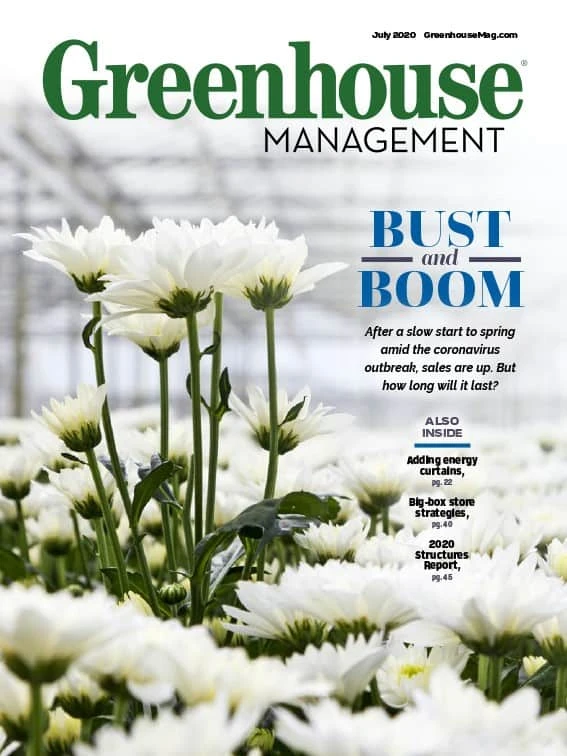

Mums are a key product for many greenhouse and nursery growers in North America. While many of the tenants of mum production are well-established, there are still a variety of issues growers must navigate.
According to Nancy Rechcigl, technical services manager for ornamentals at Syngenta, mum production largely takes place outside of a controlled environment, which means the crops are susceptible to certain pest issues.
“Since much of the garden mum production is grown primarily outside, they can be prone to invasion by several insect pests such as aphids, thrips, caterpillars and occasionally some leafminers,” Rechcigl says. “Two spotted spider mites can also be a problem and can build up quietly and quickly under the high temperatures of summer.”
As far as disease issues are concerned, she says root rot, caused by Pythium spp., and fusarium wilt, caused by Fusarium oxysporum, cause the most problems for garden mums.
“High temperatures and direct sun on the container can raise soil temperatures and cause stress to the root system,” Rechcigl says. “Then periodic rain events can sometimes cause the media to become over-saturated for a period of time. This drying and wetting of the media can cause injury to the roots, allowing an entryway for these pathogens. In the northern regions, rust diseases are also of serious concern and must be prevented with a rotation of appropriate fungicides.”
There are, however, ways for growers to have successful mum crops and deal with these issues and others.

Solving pest issues with the right products
According to J.C. Chong, professor of entomology at Clemson University, the top pest issue for mums are aphids. Common types of aphids include melon aphids and green peach aphids. He says aphids are a problem for growers during the entire production cycle.
“When the plant is being stuck, fungus gnats become a huge problem there too,” Chong says. “But as soon as the plant gets to a certain size and the growing media dries up a little bit, the fungus gnats more or less disappear. And then aphids really start to pick up.”
He says whiteflies and spider mites can also be a problem during the mum production cycle, especially if mums are being produced outside.
At Clemson, Chong has performed trials with two Syngenta products: Mainspring® GNL, an IRAC Group 28 insecticide used to combat thrips, whiteflies, aphids, caterpillars and other chewing pests, and Acelepryn®, an insecticide providing season-long control of grubs, as well as several species of caterpillars.
In Chong’s studies, he and his team looked at how the products were dealing with caterpillars, particularly armyworms, which are common in South Carolina.
For Mainspring GNL and Acelepryn, Chong trialed the products as a drench and a spray to see how long the products will work. They were applied once, but at different rates.
“What we do is drench the plant, put the leaves in a dish, offer them to the armyworm larvae and see how many survive,” Chong says. “What we are seeing is that the survival rate is extremely low. From zero to 14 days, we don’t see any of them surviving at all. For 35 days after foliar applications, we see a little bit of reduction in their mortality rate, but the mortality rate is still at about 80-90%.”
According to Chong, both sprays and drenches of Mainspring GNL and Acelepryn work well for controlling worms across all rates.


“You can really expect one foliar application to give you 30 days of protection and one drench probably giving you 39 days of protection,” Chong says.
For growers looking to decide what product is right for them, Chong recommends matching the label for what the exact needs are. Acelepryn has a narrower pest spectrum than Mainspring GNL, but for controlling worms, the two products work similarly. If growers need protection and control against a broader spectrum of pests (aphids, thrips, leafminers, etc.), then Mainspring GNL is your tool, says Rechcigl.
For controlling worms, both products work well, Chong says.
How to deal with fusarium
As noted, fusarium is a leading disease issue for mums. According to Dave Norman, an associate professor of plant pathology as the University of Florida, fusarium is a fungus common in the environment. It often gets into production during the beginning stages. During mum production, it can cause root damage, but is most harmful toward the crown of the plant.
“It primarily moves in a nursery via contaminated soil, by workers or by plants that have been brought in from an infected area,” Norman says. “It easily moves around a growing environment.” He adds that it can be especially harmful when plants are bigger or near the end of the growing cycle, and is more harmful when the weather is hot and/or humid.
“When you get into the southern states, it’s more severe, especially in the summer months when you’re getting your plants ready to sell,” Norman says.


He recommends not irrigating too late in the day to avoid the plants being wet overnight and using benches when possible to keep plants off the ground.
Some symptoms of fusarium are a dark grey stem at the soil line in young plants, crown rot and root discoloration. Younger plants, however, sometimes don’t show symptoms until they have become much larger. Combatting fusarium requires rigorous treatment with the right products, Norman says. To treat fusarium, he says it’s best to use FRAC groups 3, 7 and 11. One product that combines FRAC Groups 7 + 11 is Mural® fungicide from Syngenta. Mural can be used as a drench or a spray for effective disease control.
When a grower thinks they have a fusarium outbreak, Norman says to act quickly to try and limit the spread of spores and to at least consider sending your plants to a lab to be tested.
“It’s a very aggressive fungus for mums,” Norman says. “Some of the most popular and unique colors you come across are very sensitive to fusarium. This has to be taken seriously.”
more helpful tips
With mum production, Rechcigl says to start by thinking about rooting.
“Remember that success is all about having healthy roots,” she says. “Before placing pots out in the field, make sure the field is level with good drainage and that any low areas are fixed so standing water doesn’t accumulate. Keep plants evenly moist. If you are using drip tape to apply irrigation, look at the wetting pattern over time so you get proper wetting across all pots in all areas of the field.”
Scouting weekly for pests is vital, as is being prepared for any problems that could pop up. “While symptoms of fusarium wilt are typically seen in August, the initial infection began several weeks earlier,” says Rechcigl. “Protecting the roots in July is critical.”
As a resource for growers, Syngenta built an agronomic program for mum production that offers timing and treatment recommendations for the most common insect and disease targets. It’s available here.
Rooted cuttings
According to Mark A. Smith, technical service lead for Syngenta Flowers, one other market change is a shift toward unrooted cuttings vs. rooted cuttings. The cuttings are coming in around May/June if they are unrooted, with growers finishing the plants in the fall. Smith says the rise of larger growers having a propagation team in place at their facilities is a major reason why unrooted cuttings have grown in popularity.
“Mums are one of the easiest crops to root, so why not save on the input cost and do that work yourself?” Smith says. “It’s a lower cost to start with unrooted, too.” The only difference is the length of the growing cycle. Smith says if a grower wants to produce mums from unrooted cuttings vs. rooted cuttings, it’s wise to start two to three weeks earlier. Otherwise, the process — and the different issues growers can face during production – is largely the same.
“One key thing to remember is that feeding and watering mums will absolutely drive growth,” Smith says. “Mums are best on a constant liquid feed program. They need to be on a high volume of nitrogen, but they need to be fed on a regular basis.”

Explore the July 2020 Issue
Check out more from this issue and find your next story to read.
Latest from Greenhouse Management
- 2025 Proven Winners Horticulture Scholarship applications now open
- How to improve inventory and shipping management in the greenhouse
- Leading Women of Horticulture: Anna Ball, Ball Hort, and Terri McEnaney, Bailey Nurseries
- GM CEA HERB Part 2: A guide to increasing the sowing density of culinary herbs
- GM CEA HERB Part 1: Best practices for producing culinary herbs in controlled environments
- USDA fires experts on invasive pests, including Asian citrus psyllid, chilli thrips
- CEA Alliance celebrates bipartisan introduction of Supporting Innovation in Agriculture Act
- Dümmen Orange North America celebrating 25th anniversary in 2025





